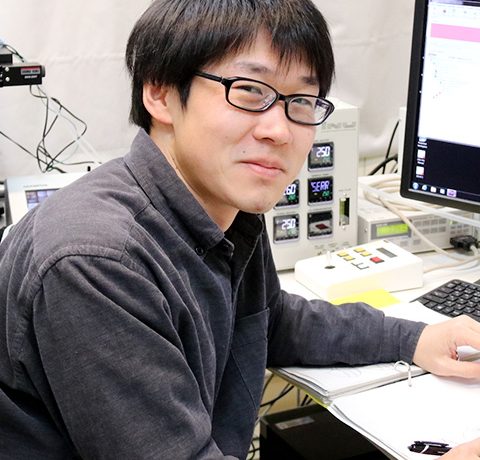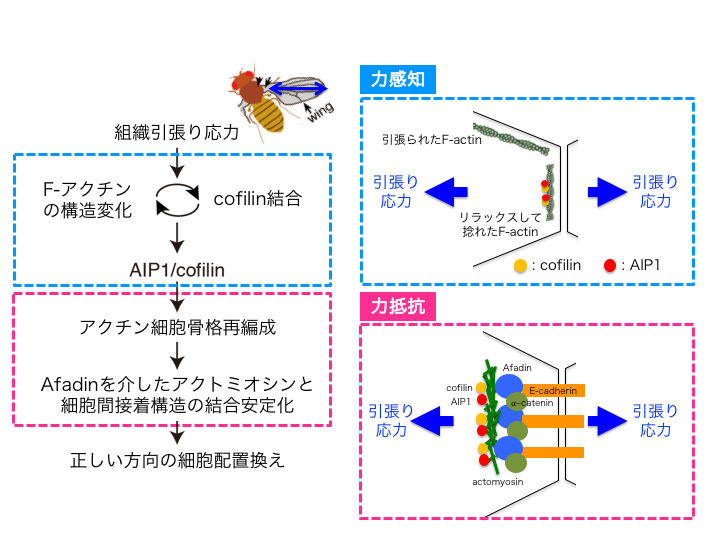Program-Specific Research Associate (Sugimura Lab)
Keisuke Ikawa
Keisuke Ikawa
Ontogenesis is a developmental process resulting in the final body shape of a multicellular organism. During this process, tissues spatiotemporally and repeatedly deform to adopt the correct shape. Dr Keisuke Ikawa, a researcher in the Sugimura Lab at iCeMS, is investigating the mechanisms underlying tissue deformation. He has recently reported the mechanisms of mechanosensing and resistance during tissue deformation.

Please share with us the significance of your manuscript in terms of its research achievements, impact, or uniqueness.

During development, tissues repeatedly deform to shape organs. When tissues undergo these deformations, cells change their relative position along the tissue axis by remodeling their cell contact surfaces. This behavior is called “cell rearrangement.” Recent studies have shown that tissue stress controls the directionality of cell rearrangement in epithelial tissues, such as the Drosophila pupal wing epithelium. However, the mechanism by which cells sense and resist tissue stress during tissue tension-driven cell rearrangement is largely unknown.
To answer this question, we focused our efforts on the actin cytoskeleton and actin binding proteins (ABPs), which can both sense and resist applied forces. To achieve this, we screened candidate ABPs, and identified actin-interacting protein 1 (AIP1) and cofilin as the mechanosensing and resistance regulators during tissue tension-driven cell rearrangement, respectively. We found that cooperative binding of cofilin to actin cytoskeleton promotes AIP1 localization to particular cell-cell contact surfaces. Moreover, we confirmed that AIP1 and cofilin control the actin turnover and cell-cell contact surfaces, which ensures resistance against tissue tension on remodeling the cell-cell junction and results in correct cell rearrangement.
What would you say is the most exciting or “I made it!” moment during this research project?
While working on a project, if you let your feelings interfere every time you collect data, there is a risk of misinterpreting the data. Therefore, it is only when I collated all the data to demonstrate the mechanosensing and resistance mechanism, that I finally felt that “I made it.”
Please tell us about the biggest challenge or problem you experienced while conducting your research. How did you overcome it?
The biggest challenge we had to tackle while working on this project was to elucidate how mechanical forces are transmitted to cellular signaling pathways which control cell rearrangement. Indeed, to understand how this affects cell behavior, we had to carefully observe and compare the phenomena occurring with and without applied forces. However, this type of analysis is difficult to perform, particularly at the tissue level.
Previous studies have shown that in our model system, the Drosophila pupal wing, surgical methods can be used to efficiently disrupt tissue stress. Therefore, this experimental advantage of our model system allowed us to examine in detail the phenomena caused by mechanical forces.
Would you consider this work to be a turning point in your overall research direction? If so, how has your research direction changed as a result of this work?
Yes, I would. As a graduate student, I was mainly interested in cell biology. After I joined the Sugimura Lab, my research interests shifted to developmental biology and tissue mechanics. To publish an article in this field of research, I first had to learn many new techniques, including fly experiments, image analysis, and quantitative biological methods. Fortunately, I benefited from the kind support of my colleagues, who helped me publish this paper. I consider that this new knowledge and these relationships with other scientists will be invaluable to my future research.
Please describe the current situation of your career. What is your current position? How has the knowledge and experience gained at iCeMS influencing your career?
I am currently a Program-Specific Research Associate in the Sugimura lab. Although I cannot yet say how my time at iCeMS will influence my career, I can tell you that while working on this project, I learned to thrive in challenging situations. I now believe that even if I’m in a difficult situation, I am able to persevere while also continuing to enjoy the research.
*All the information on this page, including the researcher’s affiliation, is current at the time of the interview.
Paper information
AIP1 and cofilin ensure a resistance to tissue tension and promote directional cell rearrangement
Keisuke Ikawa and Kaoru Sugimura
Nature Communications
Published: September 2018
DOI: 10.1038/s41467-018-05605-7